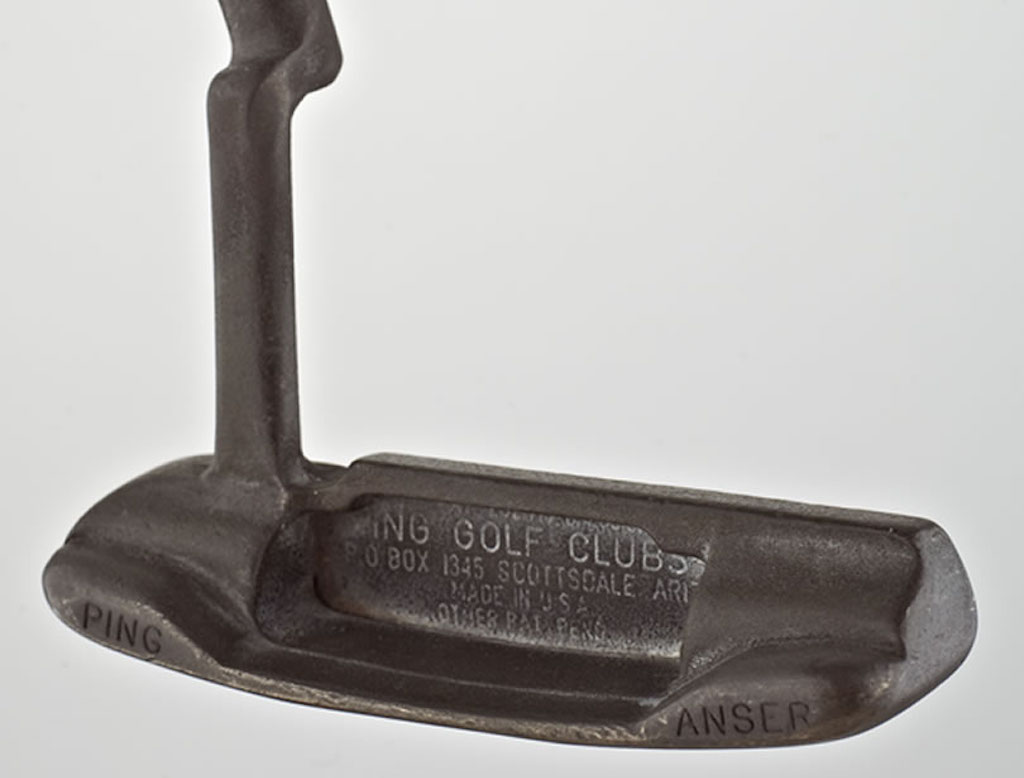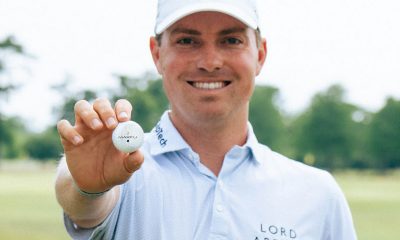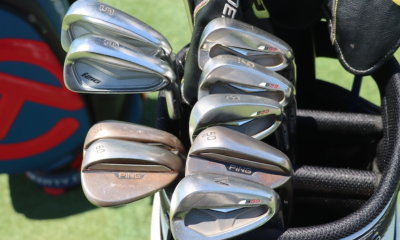Opinion & Analysis
The Wedge Guy: The best golf club innovations?

Being in the golf equipment industry for nearly 40 years, I have paid close attention to the evolution of golf equipment over its modern history. While I’ve never gotten into the collecting side of golf equipment, I have accumulated a few dozen clubs that represent some of the evolution and revolution in various categories. As a club designer myself, I ponder developments and changes to the way clubs are designed to try to understand what the goals a designer might have had and how well he achieved those goals.
Thinking about this innovation or that got me pondering my own list of the most impactful innovations in equipment over my lifetime (the past 60 years or so). I want to offer this analysis up to all of you for review, critique, and argument.
Woods: I would have to say that the two that made the most impact on the way the game is played is the introduction of the modern metal wood by TaylorMade back in the 1980s, and the advent of the oversized wood with the Callaway Big Bertha in the 1990s. Since then, the category has been more about evolution than revolution, to me at least.
Irons: Here again, I think there are two major innovations that have improved the playability of irons for recreational golfers. The first is the introduction of the numbered and matched set, a concept pioneered by Bobby Jones and Spalding in the 1930s. This introduced the concept of buying a “set” of irons, rather than picking them up individually. The second would be the introduction of perimeter weighting, which made the lower lofted irons so much easier for less skilled golfers to get airborne. (But I do believe the steadfast adherence to the concept of a “matched” set has had a negative effect on all golfers’ proficiency with the higher-lofted irons)
Putters: This is probably the most design-intense and diverse category in the entire equipment industry. History has showed us thousands of designs and looks in the endless pursuit of that magic wand. But to me, the most impactful innovation has to be the Ping Anser putter, which has been…and still is…copied by nearly every company that even thought about being in the putter business. Moving the shaft toward the center of the head, at the same time green speeds were increasing and technique was moving toward a more arms-and-shoulders method, changed the face of putting forever. I actually cannot think of another innovation of that scale in any category.
Wedges: Very simply, I’ll “take the fifth” here. To me, this is a category still waiting for the revolutionary concept to bring better wedge play to the masses. The “wedges” on the racks today are strikingly similar to those in my collection dating back to a hickory-shafted Hillerich and Bradsby LoSkore model from the late 1930s, a Spalding Dynamiter from the 50s, a Wilson DynaPower from the 70s, and so on.
Shafts: Hands down, to me the most impactful innovation is the creation of the carbon fiber, or graphite, shaft. After fruitless ventures into aluminum and fiberglass, this direction has improved the performance of golf clubs across the board. You haven’t seen a steel-shafted driver in two decades or more, and irons are rapidly being converted. Personally, I don’t see me ever playing a steel shaft again in any club – even my putter! But beyond that, I’d have to say the concepts of frequency-matching and “spine-ing” shafts made it possible to achieve near perfection in building golf clubs for any golfer.
Wild card: This has to go to the invention of the hybrid. After decades of trying to find a way to make clubs of 18-24 degrees easier to master, Sonartec and Adams finally figured this out. And golfers of all skill levels are benefitting, as this is just a better way to get optimum performance out of clubs of that loft and length.
So, there’s my review from a lifetime of golf club engineering. What can you all add to this? What do you think I missed? I hope to see lots of conversation on this one…
*featured image via Ping
- LIKE231
- LEGIT31
- WOW3
- LOL3
- IDHT3
- FLOP4
- OB1
- SHANK17
19th Hole
Vincenzi’s LIV Golf Singapore betting preview: Course specialist ready to thrive once again

After another strong showing in Australia, LIV Golf will head to Sentosa Golf Club in Singapore looking to build off of what was undoubtedly their best event to date.
Sentosa Golf Club sits on the southern tip of Singapore and is one of the most beautiful courses in the world. The course is more than just incredible scenically; it was also rated 55th in Golf Digest’s top-100 courses in 2022-2023 and has been consistently regarded as one of the best courses in Asia. Prior to being part of the LIV rotation, the course hosted the Singapore Open every year since 2005.
Sentosa Golf Club is a par 71 measuring 7,406 yards. The course will require precise ball striking and some length off the tee. It’s possible to go low due to the pristine conditions, but there are also plenty of hazards and difficult spots on the course that can bring double bogey into play in a hurry. The Bermudagrass greens are perfectly manicured, and the course has spent millions on the sub-air system to keep the greens rolling fast. I spoke to Asian Tour player, Travis Smyth, who described the greens as “the best [he’s] ever played.”
Davis Love III, who competed in a Singapore Open in 2019, also gushed over the condition of the golf course.
“I love the greens. They are fabulous,” the 21-time PGA Tour winner said.
Love III also spoke about other aspects of the golf course.
“The greens are great; the fairways are perfect. It is a wonderful course, and it’s tricky off the tee.”
“It’s a long golf course, and you get some long iron shots. It takes somebody hitting it great to hit every green even though they are big.”
As Love III said, the course can be difficult off the tee due to the length of the course and the trouble looming around every corner. It will take a terrific ball striking week to win at Sentosa Golf Club.
In his pre-tournament press conference last season, Phil Mickelson echoed many of the same sentiments.
“To play Sentosa effectively, you’re going to have a lot of shots from 160 to 210, a lot of full 6-, 7-, 8-iron shots, and you need to hit those really well and you need to drive the ball well.”
Golfers who excel from tee to green and can dial in their longer irons will have a massive advantage this week.
Stat Leaders at LIV Golf Adelaide:
Fairways Hit
1.) Louis Oosthuizen
2.) Anirban Lahiri
3.) Jon Rahm
4.) Brendan Steele
5.) Cameron Tringale
Greens in Regulation
1.) Brooks Koepka
2.) Brendan Steele
3.) Dean Burmester
4.) Cameron Tringale
5.) Anirban Lahiri
Birdies Made
1.) Brendan Steele
2.) Dean Burmester
3.) Thomas Pieters
4.) Patrick Reed
5.) Carlos Ortiz
LIV Golf Individual Standings:
1.) Joaquin Niemann
2.) Jon Rahm
3.) Dean Burmester
4.) Louis Oosthuizen
5.) Abraham Ancer
LIV Golf Team Standings:
1.) Crushers
2.) Legion XIII
3.) Torque
4.) Stinger GC
5.) Ripper GC
LIV Golf Singapore Picks
Sergio Garcia +3000 (DraftKings)
Sergio Garcia is no stranger to Sentosa Golf Club. The Spaniard won the Singapore Open in 2018 by five strokes and lost in a playoff at LIV Singapore last year to scorching hot Talor Gooch. Looking at the course setup, it’s no surprise that a player like Sergio has played incredible golf here. He’s long off the tee and is one of the better long iron players in the world when he’s in form. Garcia is also statistically a much better putter on Bermudagrass than he is on other putting surfaces. He’s putt extremely well on Sentosa’s incredibly pure green complexes.
This season, Garcia has two runner-up finishes, both of them being playoff losses. Both El Camaleon and Doral are courses he’s had success at in his career. The Spaniard is a player who plays well at his tracks, and Sentosa is one of them. I believe Sergio will get himself in the mix this week. Hopefully the third time is a charm in Singapore.
Paul Casey +3300 (FanDuel)
Paul Casey is in the midst of one of his best seasons in the five years or so. The results recently have been up and down, but he’s shown that when he’s on a golf course that suits his game, he’s amongst the contenders.
This season, Casey has finishes of T5 (LIV Las Vegas), T2 (LIV Hong Kong), and a 6th at the Singapore Classic on the DP World Tour. At his best, the Englishman is one of the best long iron players in the world, which makes him a strong fit for Sentosa. Despite being in poor form last season, he was able to fire a Sunday 63, which shows he can low here at the course.
It’s been three years since Casey has won a tournament (Omega Dubai Desert Classic in 2021), but he’s been one of the top players on LIV this season and I think he can get it done at some point this season.
Mito Pereira +5000 (Bet365)
Since Mito Pereira’s unfortunate demise at the 2022 PGA Championship, he’s been extremely inconsistent. However, over the past few months, the Chilean has played well on the International Series as well as his most recent LIV start. Mito finished 8th at LIV Adelaide, which was his best LIV finish this season.
Last year, Pereira finished 5th at LIV Singapore, shooting fantastic rounds of 67-66-66. It makes sense why Mito would like Sentosa, as preeminent ball strikers tend to rise to the challenge of the golf course. He’s a great long iron player who is long and straight off the tee.
Mito has some experience playing in Asia and is one of the most talented players on LIV who’s yet to get in the winner’s circle. I have questions about whether or not he can come through once in contention, but if he gets there, I’m happy to roll the dice.
Andy Ogletree +15000 (DraftKings)
Andy Ogletree is a player I expected to have a strong 2024 but struggled early in his first full season on LIV. After failing to crack the top-25 in any LIV event this year, the former U.S. Amateur champion finally figured things out, finished in a tie for 3rd at LIV Adelaide.
Ogletree should be incredible comfortable playing in Singapore. He won the International Series Qatar last year and finished T3 at the International Series Singapore. The 26-year-old was arguably the best player on the Asian Tour in 2023 and has been fantastic in the continent over the past 18 months.
If Ogletree has indeed found form, he looks to be an amazing value at triple-digit odds.
- LIKE2
- LEGIT3
- WOW1
- LOL1
- IDHT0
- FLOP2
- OB0
- SHANK0
Opinion & Analysis
Ryan: Lessons from the worst golf instructor in America

In Tampa, there is a golf course that boasts carts that do not work, a water range, and a group of players none of which have any chance to break 80. The course is overseen by a staff of crusty men who have succeeded at nothing in life but ending up at the worst-run course in America. However, this place is no failure. With several other local courses going out of business — and boasting outstanding greens — the place is booked full.
While I came for the great greens, I stayed to watch our resident instructor; a poor-tempered, method teacher who caters to the hopeless. At first, it was simply hilarious. However, after months of listening and watching, something clicked. I realized I had a front-row seat to the worst golf instructor in America.
Here are some of my key takeaways.
Method Teacher
It is widely accepted that there are three types of golf instructors: system teachers, non-system teachers, and method teachers. Method teachers prescribe the same antidote for each student based on a preamble which teachers can learn in a couple day certification.
Method teaching allows anyone to be certified. This process caters to the lowest caliber instructor, creating the illusion of competency. This empowers these underqualified instructors with the moniker of “certified” to prey on the innocent and uninformed.
The Cult of Stack and Jilt
The Stack and Tilt website proudly boasts, “A golfer swings his hands inward in the backswing as opposed to straight back to 1) create power, similar to a field goal kicker moving his leg in an arc and 2) to promote a swing that is in-to-out, which produces a draw (and eliminates a slice).”
Now, let me tell you something, there is this law of the universe which says “energy can either be created or destroyed,” so either these guys are defying physics or they have no idea what they are taking about. Further, the idea that the first move of the backswing determines impact is conjecture with a splash of utter fantasy.
These are the pontifications of a method — a set of prescriptions applied to everyone with the hope of some success through the placebo effect. It is one thing for a naive student to believe, for a golf instructor to drink and then dispel this Kool-Aid is malpractice.
Fooled by Randomness
In flipping a coin, or even a March Madness bet, there is a 50-50 chance of success. In golf, especially for new players, results are asymmetric. Simply put: Anything can happen. The problem is that when bad instructors work with high handicappers, each and every shot gets its own diagnosis and prescription. Soon the student is overwhelmed.
Now here’s the sinister thing: The overwhelming information is by design. In this case, the coach is not trying to make you better, they are trying to make you reliant on them for information. A quasi Stockholm syndrome of codependency.
Practice
One of the most important scientists of the 20th century was Ivan Pavlov. As you might recall, he found that animals, including humans, could be conditioned into biological responses. In golf, the idea of practice has made millions of hackers salivate that they are one lesson or practice session from “the secret.”
Sunk Cost
The idea for the worst golf instructor is to create control and dependency so that clients ignore the sunk cost of not getting better. Instead, they are held hostage by the idea that they are one lesson or tip away from unlocking their potential.
Cliches
Cliches have the effect of terminating thoughts. However, they are the weapon of choice for this instructor. Add some hyperbole and students actually get no information. As a result, these players couldn’t play golf. When they did, they had no real scheme. With no idea what they are doing, they would descend into a spiral of no idea what to do, bad results, lower confidence, and running back to the lesson tee from more cliches.
The fact is that poor instruction is about conditioning players to become reliant members of your cult. To take away autonomy. To use practice as a form of control. To sell more golf lessons not by making people better but through the guise that without the teacher, the student can never reach their full potential. All under the umbrella of being “certified” (in a 2-day course!) and a melee of cliches.
This of course is not just happening at my muni but is a systemic problem around the country and around the world, the consequences of which are giving people a great reason to stop playing golf. But hey, at least it’s selling a lot of golf balls…
- LIKE15
- LEGIT1
- WOW0
- LOL3
- IDHT1
- FLOP0
- OB0
- SHANK12
19th Hole
Vincenzi’s 2024 Zurich Classic of New Orleans betting preview

The PGA TOUR heads to New Orleans to play the 2023 Zurich Classic of New Orleans. In a welcome change from the usual stroke play, the Zurich Classic is a team event. On Thursday and Saturday, the teams play best ball, and on Friday and Sunday the teams play alternate shot.
TPC Louisiana is a par 72 that measures 7,425 yards. The course features some short par 4s and plenty of water and bunkers, which makes for a lot of exciting risk/reward scenarios for competitors. Pete Dye designed the course in 2004 specifically for the Zurich Classic, although the event didn’t make its debut until 2007 because of Hurricane Katrina.
Coming off of the Masters and a signature event in consecutive weeks, the field this week is a step down, and understandably so. Many of the world’s top players will be using this time to rest after a busy stretch.
However, there are some interesting teams this season with some stars making surprise appearances in the team event. Some notable teams include Patrick Cantlay and Xander Schauffele, Rory McIlroy and Shane Lowry, Collin Morikawa and Kurt Kitayama, Will Zalatoris and Sahith Theegala as well as a few Canadian teams, Nick Taylor and Adam Hadwin and Taylor Pendrith and Corey Conners.
Past Winners at TPC Louisiana
- 2023: Riley/Hardy (-30)
- 2022: Cantlay/Schauffele (-29)
- 2021: Leishman/Smith (-20)
- 2019: Palmer/Rahm (-26)
- 2018: Horschel/Piercy (-22)
- 2017: Blixt/Smith (-27)
2024 Zurich Classic of New Orleans Picks
Tom Hoge/Maverick McNealy +2500 (DraftKings)
Tom Hoge is coming off of a solid T18 finish at the RBC Heritage and finished T13 at last year’s Zurich Classic alongside Harris English.
This season, Hoge is having one of his best years on Tour in terms of Strokes Gained: Approach. In his last 24 rounds, the only player to top him on the category is Scottie Scheffler. Hoge has been solid on Pete Dye designs, ranking 28th in the field over his past 36 rounds.
McNealy is also having a solid season. He’s finished T6 at the Waste Management Phoenix Open and T9 at the PLAYERS Championship. He recently started working with world renowned swing coach, Butch Harmon, and its seemingly paid dividends in 2024.
Keith Mitchell/Joel Dahmen +4000 (DraftKings)
Keith Mitchell is having a fantastic season, finishing in the top-20 of five of his past seven starts on Tour. Most recently, Mitchell finished T14 at the Valero Texas Open and gained a whopping 6.0 strokes off the tee. He finished 6th at last year’s Zurich Classic.
Joel Dahmen is having a resurgent year and has been dialed in with his irons. He also has a T11 finish at the PLAYERS Championship at TPC Sawgrass which is another Pete Dye track. With Mitchell’s length and Dahmen’s ability to put it close with his short irons, the Mitchell/Dahmen combination will be dangerous this week.
Taylor Moore/Matt NeSmith +6500 (DraftKings)
Taylor Moore has quickly developed into one of the more consistent players on Tour. He’s finished in the top-20 in three of his past four starts, including a very impressive showing at The Masters, finishing T20. He’s also finished T4 at this event in consecutive seasons alongside Matt NeSmith.
NeSmith isn’t having a great 2024, but has seemed to elevate his game in this format. He finished T26 at Pete Dye’s TPC Sawgrass, which gives the 30-year-old something to build off of. NeSmith is also a great putter on Bermudagrass, which could help elevate Moore’s ball striking prowess.
- LIKE8
- LEGIT3
- WOW1
- LOL1
- IDHT0
- FLOP3
- OB1
- SHANK2
-

 19th Hole1 week ago
19th Hole1 week agoJustin Thomas on the equipment choice of Scottie Scheffler that he thinks is ‘weird’
-

 19th Hole1 week ago
19th Hole1 week ago‘Absolutely crazy’ – Major champ lays into Patrick Cantlay over his decision on final hole of RBC Heritage
-

 19th Hole2 weeks ago
19th Hole2 weeks agoTwo star names reportedly blanked Jon Rahm all week at the Masters
-

 19th Hole2 weeks ago
19th Hole2 weeks agoReport: LIV Golf identifies latest star name they hope to sign to breakaway tour
-

 19th Hole2 weeks ago
19th Hole2 weeks agoNeal Shipley presser ends in awkward fashion after reporter claims Tiger handed him note on 8th fairway
-

 19th Hole2 weeks ago
19th Hole2 weeks agoBrandel Chamblee has ‘no doubt’ who started the McIlroy/LIV rumor and why
-

 Equipment3 weeks ago
Equipment3 weeks agoWhat we know about Bryson DeChambeau’s 3D-printed Avoda irons
-

 19th Hole5 days ago
19th Hole5 days agoLET pro gives detailed financial breakdown of first week on tour…and the net result may shock you
























Lance Manion
Jul 22, 2019 at 4:17 pm
Wedges are stagnant at best…much needed innovation. Hope to see something sooner than later.
ChipNRun
Jul 1, 2019 at 3:31 pm
Oops, hybrid description flew OB! The early 2000s did NOT herald the invention of the hybrid. Rather, it marked the return of the Bulldog, a trouble club from the late 1800s through hickory age. The Bulldog had a very small head – exemplified by a clubface the width of two golf balls … a shorter shaft and about 25* loft… and was used to chop the ball out of moderate rough.
For picture of replica, see: https://louisvillegolf.com/products/25-degree-bulldog
michael kirby
Jun 29, 2019 at 6:51 pm
Well done.
Informative. Concise. Quality information.
Peter
Jun 27, 2019 at 8:26 pm
Under wedges a good try was TM with the replaceable face. Didn’t stick around but it was still a good idea. I wonder if vokey or Cleveland did this if it would have been more popular.
Mike CR
Jun 27, 2019 at 9:41 am
The ball has seen a big change. If you ever played balata you would agree. The new balls are longer and straighter and don’t smile at you after hitting it in the belly with your sand wedge.
Daniel Poehler
Jun 27, 2019 at 7:59 am
Good article, Terry. One innovation that I believe we can add is the addition of grooves to the face of putters to start the ball on a forward roll as soon as it’s struck as oppose to a skid then roll. I believe the “Yes” putters started the trend and now vertually every manufacturer has their version of this.
Big Wally
Jun 27, 2019 at 4:49 am
I would say hollow head drivers and perimeter weighting in irons and putters for sure but in terms of evolution it has to be the golf ball. From gotta percha to the Haskell to balata to today’s urethane the ball goes further, straighter and lasts longer because it doesn’t cut.
Scott
Jun 27, 2019 at 5:15 pm
yes, the ball. Maybe the biggest change of all, not even on the list.
Terry Koehler
Jun 28, 2019 at 10:01 am
I can certainly agree, Scott. But I was focused on clubs with my list. There is certainly no question that the evolutionary/revolutionary changes to the golf ball have impacted the game a great deal, maybe more than all the things I listed combined!!!
Good call.
Tom54
Jun 26, 2019 at 6:58 pm
I concur with the larger headed drivers as being very influential. I’m not sure of its size compared to today’s 460 cc limit, but the first time I remember hitting my Biggest Big Bertha , I swear I thought I was cheating. How could you miss these things I thought? The ball looked like a pea sitting there on the tee next to that head.
The Boss
Jun 26, 2019 at 5:11 pm
The biggest innovation on the horizon is owned by Green Golf; get ready to scrap all of your putters.
DrRob1963
Jun 26, 2019 at 5:08 pm
I recall seeing an interview with Gene Sarazen, where he was asked if his addition of bounce to a wedge (to create the modern sand wedge) was the greatest invention in golf.
“No!”, he replied. “it was the lawn-mower!”
Robin
Jun 26, 2019 at 4:07 pm
Hat to cover bald spot .
dtrain
Jun 26, 2019 at 3:12 pm
TM Pittsburg persimmon
Big Bertha/Great big bertha
Ping Eye 2
Ping Anser
TM Rescue clubs
PXG…I jest, I jest.
Nils Nelson
Jun 26, 2019 at 2:57 pm
Wild Card: The Izzo Dual Strap golf bag.
James
Jun 26, 2019 at 2:56 pm
Please elaborate on that last comment regarding irons?
Terry Koehler
Jun 26, 2019 at 5:44 pm
Thank you James, That is probably a good dive for a future article. Stay tuned!!!
Ty Web
Jun 26, 2019 at 2:56 pm
Advanced Bermuda grass strains for anyone in the south.
Corey Knapp
Jun 26, 2019 at 2:45 pm
The sand wedge!
bobbyg
Jun 25, 2019 at 3:57 pm
The best golf club innovations? The slot. Thank you Wilson, Adams, and Nike, or anyone else I have failed to mention. Put one with the secret sauce in a club face and the ball goes further. Plus it keeps errant shots from going too far off line while also expanding the sweet spot for hacks like me.
William Davis
Jun 26, 2019 at 6:19 am
Wilson Reflex circa 1978? made an odd noise and I snapped face of 7 iron which was supposed to be impossible. Still, happy days.
For all the club improvements I understand handicaps have not followed suit.
Doug
Jun 25, 2019 at 12:54 pm
Terry, sole grinds evolved with turf conditions. I’m not sure what the club would be that was the revolution, but my limited knowledge points me toward Ping irons with wider soles for more effective bounce and a lot of radius along the leading edge. When fairways got more plush, those irons delivered improved turf interaction for a lot of players. Your own wedge designs reflected improvements that have been much copied in modern iron soles. A lot of attention is now paid the bottom of iron heads and you had a big part in that.
scooter
Jun 25, 2019 at 12:19 pm
Not just the metal wood, but the 460cc driver complete with all the innovations that led to increased trampoline effects, improved forgiveness, and the max COR limit. Also, the large number of options in high-MOI mallet putters, not just Ping Anser style.
Greg
Jun 25, 2019 at 12:07 pm
Can you expand upon your thoughts regarding this:
But I do believe the steadfast adherence to the concept of a “matched” set has had a negative effect on all golfers’ proficiency with the higher-lofted irons
Johnny Penso
Jun 25, 2019 at 8:47 pm
That statement would make more sense is he had said, “proficiency with the lower lofted irons”, meaning, many players would probably benefit from a 4-6 hybrid in place of a 4-6 iron.
Jake
Jun 26, 2019 at 3:06 pm
Thought the same thing. If he did mean proficiency with wedges, etc. would be good to have a little explanation. ???????
Christopher
Jun 25, 2019 at 11:33 am
I would argue that the modern (sand) wedge itself was the innovation, the bounce and sole was a huge benefit to golfers.
Rich
Jun 25, 2019 at 10:56 am
Agreed. Additional: rangefinders, professional-level solid ball, soft spikes, cast irons (implied in perimeter weighting), high MOI everywhere.
Robert
Jun 25, 2019 at 10:19 am
Golf carry bag with a stand
Range finder
Born
Jun 25, 2019 at 10:14 am
I’d say the Innovation of moving from wooden to steel shafts changed the game more significantly across the board when compared to graphite innovations
TR1PTIK
Jun 25, 2019 at 2:48 pm
I’d beg to differ. The ability to create more diverse profiles via graphite makes it the more significant innovation. The only major drawback of graphite shafts is a lack of weight for higher swing speed/stronger players who need it and even that is starting to be addressed.
The dude
Jun 25, 2019 at 9:41 am
Shoukd be top golf equipment innovations….and then you could include the golf ball….the BIGGEST revolution in golf…
Speedy
Jun 25, 2019 at 1:50 pm
Right on, Dude. Ball go far.